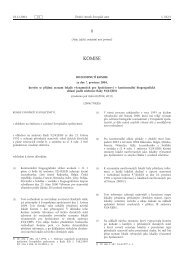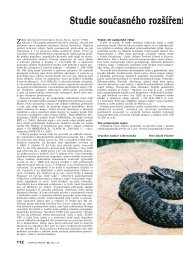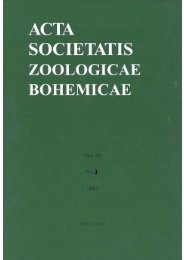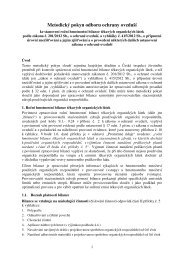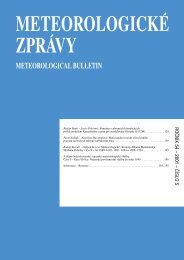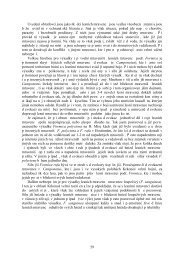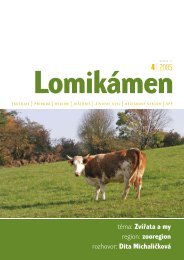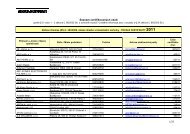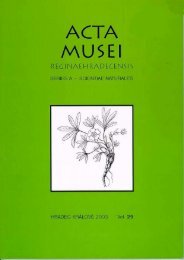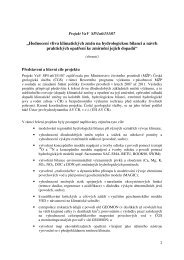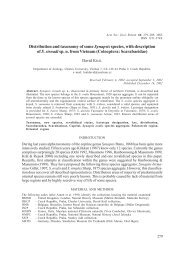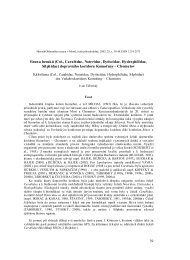journal of forest science
journal of forest science
journal of forest science
Create successful ePaper yourself
Turn your PDF publications into a flip-book with our unique Google optimized e-Paper software.
Membership value<br />
Membership value<br />
.<br />
.<br />
.<br />
.<br />
.<br />
.<br />
.<br />
.<br />
Fig. 4. Membership functions for fuzzy sets used in fuzzy reasoning mechanism<br />
THEN y = 0.3x – 20x + 0.5x + 6x (Big)<br />
3 1 2 3 4<br />
I x is ‘Small or Medium’ and x is ‘Medium or<br />
1 2<br />
Small’ and x is ‘Big or Medium’ and x is ‘Small’<br />
3 4<br />
THEN y = 0.2x – 30x + 0.3x + 4x (Medium)<br />
4 1 2 3 4<br />
I x is ‘Small or Medium’ and x is ‘Medium or<br />
1 2<br />
Small’ and x is ‘Small’ and x is ‘Big or Medium’<br />
3 4<br />
THEN y = 0.1x – 40x + 0.1x + 2x (Small)<br />
5 1 2 3 4<br />
I x is ‘Small or Medium’ and x is ‘Medium or<br />
1 2<br />
Small’ and x is ‘Small’ and x is ‘Small’<br />
3 4<br />
THEN y = –5x – 50x – 0.5x – 20x (Very Small)<br />
6 1 2 3 4<br />
where x , x , x and x are the factors such as the distance be-<br />
1 2 3 4<br />
tween passing points, gradient between passing points, horizontal<br />
distance toward the point on the road end and the vertical<br />
distance toward the point on the road end. These factors are<br />
described in detail in YOSHIMURA (1997).<br />
The membership functions shown in ig. 4 are applied<br />
to the actual values for four factors to determine the degree<br />
<strong>of</strong> truth for the premise <strong>of</strong> each rule.<br />
The method for selecting passing points and laying out<br />
gradelines differs from the method described by<br />
YOSHIMURA (1997) in two ways:<br />
1. The cells where the estimated skidding distance does<br />
not exceed the technological length <strong>of</strong> a cableway system<br />
route or effective tractor skidding distance are selected<br />
as possible passing points.<br />
2. The passing points are interconnected by applying<br />
a directional path distance model (GAO et al. 1996)<br />
implemented in the Arc/Info GRID module PATHDIS-<br />
TANCE. The path distance model automatically lays<br />
out the gradeline between passing points using an additional<br />
factor in the distance measure (surface, gradi-<br />
ent and horizontal direction factor). This model enables<br />
the expression <strong>of</strong> criteria which influence the<br />
location <strong>of</strong> the road called “friction”. The friction indicates<br />
the absolute/relative cost or degree <strong>of</strong> risk assessment<br />
<strong>of</strong> moving through each cell. Minimizing the<br />
friction between two passing points is controlled by<br />
a gradient factor which takes into consideration the<br />
effect <strong>of</strong> the value gradient from a cell to its neighbours.<br />
The formula used to calculate the lowest total cost to<br />
each <strong>of</strong> the neighbours and control gradeline projection<br />
is:<br />
CostDistance = SurfaceDistance × Verticalactor<br />
Vertical factor<br />
(y-axis)<br />
Fig. 5. The binary vertical factor graph used in the PATH-<br />
DISTANCE function<br />
310 J. FOR. SCI., 47, 2001 (7): 307–313<br />
Membership value<br />
Membership value<br />
.<br />
.<br />
.<br />
.<br />
.<br />
.<br />
.<br />
.



